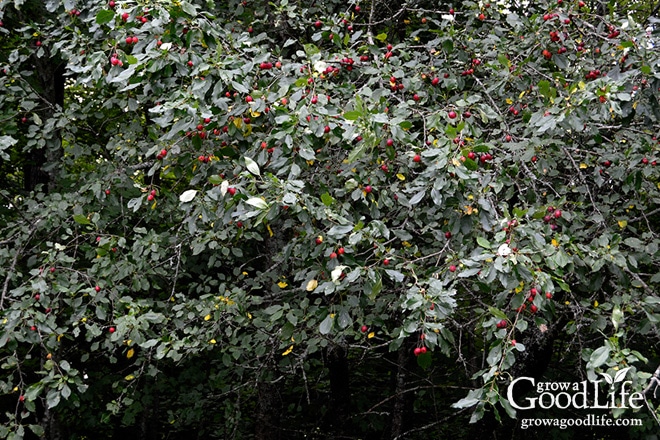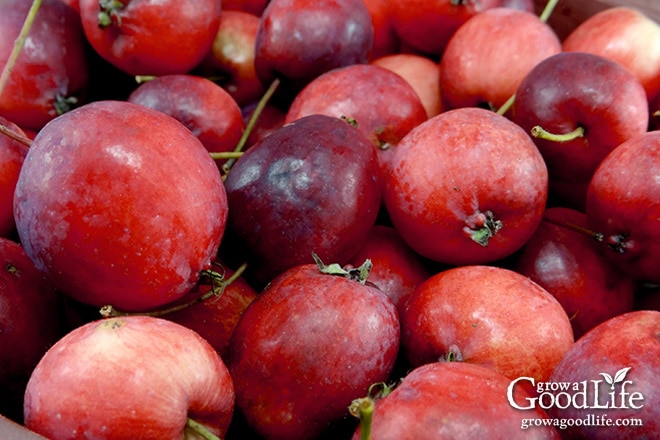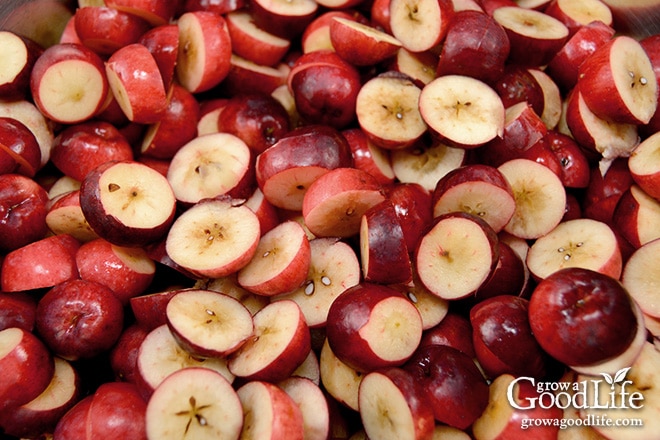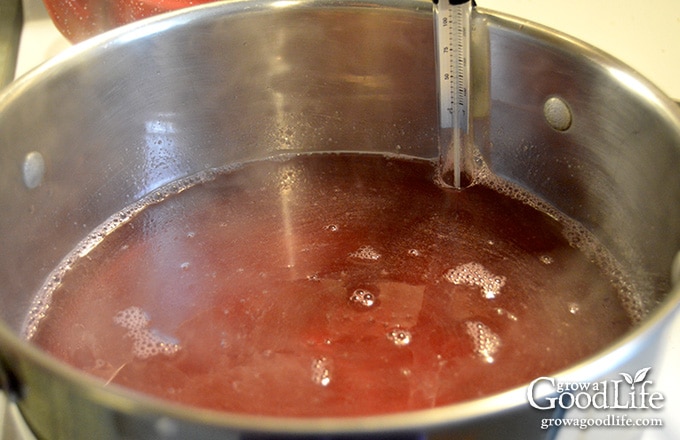Homemade Crabapple Jelly with No Added Pectin
This post may contain affiliate links, which means that I may receive a commission if you make a purchase using these links. As an Amazon Associate I earn from qualifying purchases.
Transform the tart flavor of crabapples into a delicious homemade crabapple jelly. Crabapples have enough natural pectin so no additional pectin is needed for this crabapple jelly recipe.

One of the fruit trees on the edge of our property is a crabapple tree. These are often planted along with traditional apple trees to help with pollination. They are hearty trees that don’t require much care.
Both crabapples and apples are in the Rosaceae family, and members of the Malus genus. Crabapples are small trees often reaching about 15-to 25-feet at maturity. The fruit is under two-inches in diameter and the flavor is very tart. My crabapples ripen before the rest of the apple trees, so I like to take advantage of their ruby goodness.

With a little sweetening, crabapples can be transformed into a delicious crabapple jelly that can be enjoyed on homemade bread, swirled into yogurt or paired with roast pork.
Tips for Making and Canning Homemade Crabapple Jelly
Jellies are made by heating juice with sugar, and need the right mixture of fruit, pectin, acid, and sugar for it to form a gel. Pectin is a naturally occurring complex carbohydrate in fruit that is concentrated in the fruit’s skin and the core. When pectin is cooked with sugar, it thickens to a gel.
Crabapples contain lots of natural pectin, so no additional pectin is needed for this recipe. Here are tips for making crabapple jelly:
Use good quality crabapples
Select firm crabapples with no signs of insect or worm damage. Unripe fruit has more pectin than ripe fruit, but ripe fruit has more developed flavor. So try to mix about 75% ripe fruit with 25% under ripe fruit. You can tell if an apple is ripe by cutting it open and looking at the seeds. A mature crabapple will have brown seeds, and an under ripe apple will have light colored seeds.

Give yourself plenty of time
Allow time for the crabapple juice to strain. When making juice or jelly, I typically split the process over a few days to allow extra time for the juice to strain completely. This is even more important with crabapple jelly because you want to get as much of the natural pectin from the juice as you can so your jelly thickens up properly.
Don’t double the batch
Follow the recipe, and work in small batches when making crab apple jelly. Since you are counting on the natural pectin found in the fruit, you don’t want to overheat the mixture. If you double the recipe, it will take longer to heat to the proper temperature. Too much heat will destroy the pectin, and it will break down and fail to gel.
How to test for jelly stage
If you are new to making jelly, the NCHFP website has a nice description of how to tell when the jelly point has been reached: Testing Jelly without Added Pectin.
- Temperature Test: Use a candy thermometer to monitor the temperature of the jelly. Jelly stage is when the temperature of the boiled juice is 220˚F at altitudes of less than 1,000 feet (see notes for altitude adjustments).
- Spoon or Sheet Test: Plunge a cool metal spoon into the boiling jelly mixture, lift the spoon out, and turn it sideways so the liquid runs off the side. The jelly stage had been reached when the liquid forms two drops that flow together into a sheet that hangs off the edge of the spoon.
- Refrigerator/Freezer Test: Place several plates in the freezer before you begin making your jelly. To check for jelly stage, place a spoonful of hot jelly onto the cold plate and let it rest for 30 seconds. Tip the plate to one side. Jelly stage is reached when the mixture gels on the cool plate and doesn’t run down the plate when tipped.
Cooking time will vary with each batch because the natural pectin level is different in each individual apple. I use all three testing methods but rely on the freezer plate method for the final check.
Don’t have a water bath canner?
You can use a large pot with a lid as a water bath canner to process the jars. You will need a pot that will hold 6 half-pint sized jars in a single layer with some space in between the jars. The pot also needs to be tall enough to cover the tops of the jars with 2-inches of water, plus 2-inches of additional space to prevent boiling water from splashing out of the pot. Place a rack in the bottom to elevate the jars up away from direct heat, and allow the water to circulate around the jars as they are processed.
Steps for Making Crabapple Jelly
To make jelly, we are going to extract the juice and natural pectin from the crabapples, combine it with sugar, and cook it to evaporate moisture and form a thick spreadable jelly.
If you are new to canning or haven’t canned in a while, it may be helpful to review this article on water bath canning at the National Center for Home Food Preservation website.
A more detailed and printable recipe can be found at the bottom of this article, but these are the illustrated steps for making crabapple jelly.
Step 1: Gather Your Equipment
You will need:
- Water bath canner or large pot with a rack
- 6 half-pint canning jars
- Lids and bands (new lids for each jar, bands can be reused)
- Canning tools: jar lifter, canning ladle, funnel, and bubble popper
- Jelly strainer
- Candy thermometer
- Kitchen scale
- Plus basic kitchen supplies such as a large pot, large bowl, towels, potato masher, measuring cup, knife, and a cutting board.
Step 2: Prepare the Fruit and Extract the Juice
Wash the crabapples plain water, remove stems, cut out any bad spots, and trim the blossom ends. Cut the crabapples in half. Use a kitchen scale to weigh out 3 pounds for this recipe.

Extract the juice by combining the prepared crabapples in a large saucepan with enough water so that the fruit is barely covered, about 3 cups.
Bring the pot to a boil over medium-high heat, and then reduce to a simmer. Cook while stirring occasionally to prevent sticking. As the fruit softens and breaks down, gently mash with a potato masher, and continue simmering over low heat for about 20 minutes. Don’t be tempted to increase the temperature to speed things up, because too much heat will destroy the pectin.
Strain the juice through a damp jelly bag or double layers of cheesecloth. Allow the fruit to strain for several hours, or overnight in the refrigerator. If you want clear jelly, don’t squeeze the bag. When the jelly is finished straining, compost the solids.
Step 3: Prepare the Canning Equipment
When you are ready to make the jelly, gather your canning equipment, prepare the jars, set up the canner, and organize your work area.
Wash your jars, lids, bands, and canning tools in warm, soapy water. Rinse well, and set the lids, bands, and tools aside to air dry until you are ready to use them. As you wash the jars, look them over for nicks and cracks. Eliminate any jars that are damaged as these will break in the canner.
Jars must be heated before filling to prevent breakage due to thermal shock. Place the jar rack into the water bath canner, set the jars upright in the canner, and add water to cover the jars. Bring the canner to a simmer (180˚F) for 10 minutes, and keep the jars hot until you are ready to fill them.
Step 3: Make the Jelly
Place several plates in the freezer before you begin making your jelly. These will be used to test the jelly.
Attach the candy thermometer to a large saucepan, and pour 4 cups of crabapple juice into the pan. Add the sugar, and stir to dissolve. Bring the juice to a boil over medium-high heat, stirring constantly, until jelly stage. Skim off any foam that forms.
Jelly stage is achieved once the temperature reaches 220˚F at altitudes of less than 1,000 feet (see notes for altitude adjustments), when the liquid forms a sheet that hangs off the edge of the spoon, and when the mixture gels on a cool plate and doesn’t run when tipped.

Step 4: Can the Jelly
Spread a kitchen towel on the counter. Use the jar lifter to remove a hot jar from the canner, drain, and place on the towel. Keep the remaining jars in the canner, so they stay warm.
Place the canning funnel on the jar, and ladle hot jelly into the jar while leaving 1/4-inch headspace. Run the bubble popper through the jar to release any trapped air bubbles.
Wipe the rim with a damp towel to remove any residue. Center a lid on the jar, place the band over the lid, and screw it on until fingertip tight. Place the jar back into the canner, and repeat with the rest of the jars.
Adjust the water level so it is covering the jars by several inches, bring the pot to a boil, and process the jars for the times indicated in the recipe below. Let the jars cool, test the seals, label and date the jars, and store in a cool, dark location.

Homemade Crabapple Jelly with No Added Pectin
Instructions
Extract the Juice:
- Wash the crabapples well in plain water, remove the stems, cut out any bad spots, and trim the blossom ends. Cut the crabapples in half. Use a kitchen scale to weigh out 3 pounds.
- Extract the juice by combining the prepared crabapples in a large saucepan with enough water so that the fruit is barely covered, about 3 cups.
- Bring to a boil over medium-high heat, then reduce to a simmer, and cook the crabapples. Heat and simmer slowly until skins have softened, and the juices are released.
- Gently mash the crabapples with a potato masher and simmer over low heat for about 20 minutes, stirring occasionally. Do not overcook crabapples because excess heat will destroy the pectin and change the flavor and color.
- Strain the cooked fruit through a damp jelly bag or double layers of cheesecloth. Allow the crabapples to strain for at least 2 hours or overnight in the refrigerator.
- If you want clear jelly, do not squeeze the bag. I care more for flavor rather than appearance, so I often give the bag a squeeze to press out all the flavorful juice. Discard solids.
Prepare the Canning Equipment
- Wash your jars, lids, screw bands, and canning tools in hot soapy water. Rinse thoroughly to remove all suds. Set aside to air dry on a clean kitchen towel.
- Place the jar rack into water bath canner, place jars in the canner, and add water to cover.
- Bring the canner to a simmer (180˚F) for 10 minutes, and keep the jars hot until you are ready to fill them.
Make the Jelly
- Measure 4 cups of crabapple juice and pour it into a saucepan, add the sugar and stir to dissolve. Bring to a boil over medium-high heat, stirring constantly, until jelly stage.
- Jelly stage is achieved once the temperature reaches 220˚F at altitudes of less than 1,000 feet (see notes for altitude adjustments), when the liquid forms a sheet that hangs off the edge of the spoon, and when the mixture gels on a cool plate and doesn't run when tipped.
Can the Jelly
- Lay a kitchen towel on the counter. Use the jar lifter to remove a jar from the canner, drain the water back into the canner, and place it on the towel. Keep the remaining jars in the canner so they stay hot.
- Use your canning ladle and funnel and add the hot jelly to the warm jar leaving 1/4-inch headspace. Swirl your bubble popper through to release air bubbles, and wipe the rim of the jar with a damp towel to remove any sticky residue.
- Center a lid on the jar, and screw on the band until it is fingertip tight. Use the jar lifter to place the jar back into the canner, and repeat with the remaining jars. Try to leave some space in between the jars.
- Once all the jars are in canner, adjust the water level to two inches above the jar tops.
- Cover the canner and bring to boil over high heat. Once the water boils vigorously, continue boiling for 10 minutes at altitudes of less than 6,000 ft. (adjust processing time for your altitude if necessary – see notes below).
- When processing time is complete, turn off heat and allow the canner to cool down and settle for about 5 minutes.
- Spread a dry kitchen towel on the counter. Remove the cover by tilting lid away from you so that steam does not burn your face.
- Use the jar lifter to lift jars carefully from canner and place on the towel. Keep the jars upright, and don't tighten bands or check the seals yet. Let the jars sit undisturbed for 12 to 24-hours to cool.
- After the jars have cooled for at least 12 hours, check to be sure jar lids have sealed by pushing on the center of the lid. The lid should not pop up. If the lid flexes up and down, it did not seal. Refrigerate the jar and use up within a few weeks.
- Remove the screw on bands and wash the jars. Label and date the jars. Store your jars in a cool, dark place and use within 12 to 18 months. Yields about 4 to 6 half-pint jars depending on the natural pectin level in your crabapples. Refrigerate the jelly once opened and consume within 2 weeks.
Notes
- Temperature Test: Adjustments for altitude: 1,000 feet = 218˚F, 2,000 feet = 216˚F, 3,000 feet = 214˚F, 4,000 feet = 212˚F, 5,000 feet = 211˚F, 6,000 feet = 209˚F, 7,000 feet = 207˚F, 8,000 feet = 205˚F,
- Processing Time: Adjustments for altitude: 6,001 – 8,000 feet = 15 minutes, above 8,001 feet = 20 minutes.
Nutrition
This recipe was originally published September 4, 2015. It has been reviewed, updated with additional information, and new photos.
Additional Canning Information:
You May Also Like:
- Concord Grape Jelly
- Chokecherry Jelly
- Spiced Apple Jelly with No Added Pectin
- Other Ways to Preserve Apples
Good planning is key to a successful vegetable garden
Whether you are new to growing your own food or have been growing a vegetable garden for years, you will benefit from some planning each year. You will find everything you need to organize and plan your vegetable garden in my PDF eBook, Grow a Good Life Guide to Planning Your Vegetable Garden.



What is the purpose of a water bath? I have never do e it with any other jelly – have used cherries, high bush cranberry, blueberries and concord grapes.
Renee, The purpose of a water bath canning process is to safely preserve the jelly by killing off any harmful microorganisms that can cause spoilage, including molds, yeasts, and bacteria like botulism. By boiling the filled jars for a specific amount of time, the water bath helps ensure the jelly will remain shelf-stable for a long period.
Even though you may not have done it before with other jellies, it’s recommended to water bath can all fruit-based preserves to reduce the risk of spoilage and ensure your jars seal properly. This step provides an extra layer of food safety, especially when storing your jars for months at a time. You can learn more about canning at the National Center for Food Preservation.
excited to try this recipe with my new backyard crab apple tree! One question, should I remove the seeds or is it okay to simmer those? thanks!
Gaby, It’s ok to simmer with the seeds. They will be removed when strained.
Just wondering if you can combine different kinds of crabapples when making jelly. I found some ornamental crab apples but didn’t have enough to make jelly so bought some others at a farmers market. The ornamental ones are very small, while the ones I bought are quite large and not as dark in color. Wondered if that would be problematic then to combine them!
Susan, Yes, you can combine different types of crabapples along with regular apples for this recipe.
I have been making jelly with this over the past three years and have many an adventure with it in good ways. First year, it went perfectly! Delightfully tart with a hint of sweet and probably stressed too much about doing it perfectly. The second year, it turned into syrup, too much water content left in the juice, but great for pancakes! The third year, I got jelly again! Just made a few modifications!
If anyone else has a similar problem I think the cause was that I used a stock pot… reduce the water you add by a little bit for this because a saucepan allows for more evaporation. I found it tolerant to reducing the juice sugar mixture when the water content was too high. in my impatience I added more sugar (molasses) ~2 TBSPs because I ran out of sugar and the stores were closed. My jelly darkened and took on a hint of caramel when I did that this year. Still tasty! Additionally I scaled up the recipe to 10 lbs and got ~ 3.6 L of jelly. I used a ratio of 1 lb crab apple : 1 cup water : 1 cup sugar. Next year I think I might do a ratio of 1 lb crab apple : 3/4 cup water : 1 1/8 cup sugar when using a stock pot.
Emily, It sounds like you’ve had quite the jelly-making adventure over the years! 🙂 Thank you for sharing your experiences and the modifications you’ve made. It’s wonderful to hear about your creative solutions to adjust the recipe to your liking. The idea of using a stock pot and adjusting the water content to account for the pot’s characteristics is a valuable tip for others. Your experimentation with adding molasses and the resulting hint of caramel flavor sounds intriguing and delicious. I appreciate you sharing your journey with us, and I hope your future batches turn out just as tasty!
Could I reduce the sugar and it still be safe for water bathing?
Gypsy, You cannot reduce the sugar in this recipe. Since this is a no pectin recipe, sugar is needed to form the gel. The mixture needs a balance of liquid, sugar, pectin, and acid. This apple jelly recipe works because apples contain a lot of natural pectin and are acidic. Once the apples are juiced, combined with sugar, and heated, it turns into jelly.
If you want to go low sugar, you will need to add pectin. Try this No Sugar Apple Jelly recipe from my friend, Colleen at Grow Forage Cook Ferment.
Hello, I’ve checked your recipe and the extended directions and I can’t find when I’m supposed to add the sugar. Is it after I cook the apples with water or during the cooking process? It’s not clear to me.
Darleen, The sugar is added in step 2 of the “Make the Jelly” section: “Measure 4 cups of crabapple juice and pour it into a saucepan, add the sugar and stir to dissolve. Bring to a boil over medium-high heat, stirring constantly, until jelly stage.”
How much sugar to add?
Myrna, The ingredient measurements are listed in the recipe: 3 pounds crabapples, 3 cups water, and 3 cups sugar.
This is the first jelly I’ve ever tried making and it turned out delicious! I think the canning went well, but my jelly has many small bubbles in it, almost as if it’s carbonated, is there a particular reason for this and will it last as long? I tried skimming off most of the foam but some of it seemed to harden and was difficult to get. Thanks!!
Ruby, I’m glad to hear your crabapple jelly turned out delicious! The small bubbles you’re seeing in the jelly are quite common and are generally caused by trapped air during the canning process. As long as you followed the recipe, they won’t affect the safety or shelf life of the jelly. Over time, some of the bubbles may naturally rise to the surface and disappear.